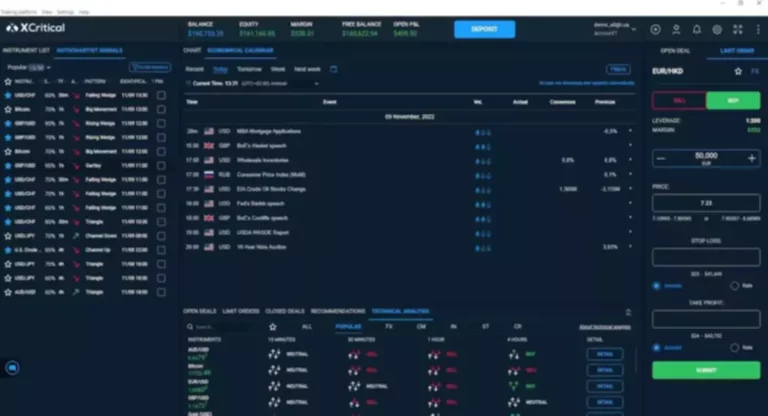Content
LPs earn a fraction of the transaction fees generated by the trading activity within the pool. Furthermore, liquidity is not the only factor in the adoption of the technology, but it stands to be a critical component in how the market matures. One approach to solving the challenges that exist in decentralized exchanges is to reduce the cost of the https://www.xcritical.com/ switch for cryptocurrency traders.
Global Expansion and Localization
However, supervisors must understand the strengths and limitations of blockchain analytics tools. Despite the ambiguity on this front, What is Crypto Liquidity virtual currency use is growing, albeit slower than in the past. A clear stance by authorities on issues like consumer protection and taxation could interest more people in using Bitcoin, which would positively affect its liquidity.
#Benefits of Aggregated Liquidity for Users and the Exchange
- That will give them the confidence that they can get into or out of a position without fear of wide price jumps, even during market fluctuation.
- As the investor can not execute the entire order at the best offer, the trade is moved down the order book.
- The classification of XRP as a commodity or security remains a contentious issue, which could have implications for ETF approval.
- Liquidity risk occurs when a user wants to trade a coin, but there aren’t enough people to buy or sell at the price they want.
- Cryptocurrency markets are distinguished by several unique factors, including their decentralised nature, the global and continuous trading environment, and the diverse range of participants.
- Through my expertise, I strive to empower individuals with the knowledge and tools they need to navigate the exciting realm of digital assets.
Your team can make decisions swiftly and efficiently, reducing the chances of mistakes. Moreover, good governance promotes accountability, so if something goes wrong, there’s a clear path to fix it. Strong infrastructure Non-fungible token and backup plans are vital to keep your platform running smoothly, no matter how intense the market becomes. In the case of algorithmic market making it is good practice to choose solutions that enable parametrization and tuning up of execution according to the current market situation.
Crypto Liquidity and XRP’s Price Plunge
Exchanges, which want to attract not only small but also bigger investors, should monitor market impact and other important liquidity metrics in all of their markets. Building on the success of Bitcoin ETFs, Ethereum ETFs were the next to gain regulatory approval. These funds, which track the price of Ether (ETH), the native cryptocurrency of the Ethereum network, launched in July 2024. The cryptocurrency ETF landscape has significantly evolved in recent years, with several major milestones paving the way for broader adoption of these investment vehicles. The recent launch of Orderly’s perps omnichain orderbook on Solana marked an important milestone, being the first time EVM and non-EVM orders had been combined into a single perps orderbook.
Lessening the Impact of Regional Sell-offs

High-profile hacks, where millions or even billions of dollars’ worth of digital assets are stolen, have occurred with alarming frequency. As the cryptocurrency market continues to mature, enhancing crypto liquidity will likely remain a primary focus. Despite the challenges, through mechanisms like liquidity aggregators and regulatory improvements, the future of crypto liquidity appears promising. As participants in this exciting financial revolution, it is crucial to understand and monitor liquidity as we navigate the dynamic world of cryptocurrencies. As a crypto exchange platform, your clients rely on you to provide a secure space for their trading activities. Implementing solid risk management strategies not only builds your customers’ trust but also protects their assets, even during the most turbulent market fluctuations.
The model you’re working with can change how liquidity is provided, how prices are discovered, and where assets are kept. First, trading volume plays a significant role because it ensures a steady flow of assets, which improves liquidity when there is more activity and numerous buy and sell orders. The importance of liquidity extends beyond trading; it also impacts users’ ability to swiftly enter or exit positions at favorable prices. Exchanges must actively manage liquidity by attracting market makers, providing incentives for liquidity provision, and ensuring that trading pairs have sufficient depth.
Let’s explore the top challenges that liquidity management encounters in the realm of cryptocurrencies and how they impact the financial ecosystem. Token-to-token convertibility is not the only approach to solving the liquidity challenge. What happens locally in markets can trigger some wild sell-offs on regional exchanges, which in turn impacts the global crypto market. For example, when martial law was declared in South Korea, local exchanges saw a major sell-off, which created a ripple effect that affected global prices. Several platforms and tools support liquidity aggregation, such as APIs and software solutions providing the ability fo exchanges to connect with the surplus liquidity pool or even external DEXs.

Besides, cryptocurrencies don’t offer traders the same level of insurance traditional investments do. Changing regulations also means that crypto trading could be subject to complex tax implications, depending on your client’s location. The integration of cross-chain technologies and interoperability solutions could address the issue of market fragmentation, leading to a more cohesive and liquid market. These advancements, coupled with increasing global adoption of cryptocurrencies, suggest a trend towards greater market stability and efficiency. Prices that align with the market supply and demand are essential for any functioning marketplace. The price of tokens in a liquidity pool is determined by the ratio of tokens in the pool.
She is a financial therapist and transformational coach, with a special interest in helping women learn how to invest. Request a demo to see how AlphaPoint can empower your platform with the security and reliability your customers deserve. Exchanges need to implement robust Know Your Customer (KYC) and Anti-Money Laundering (AML) practices during their user onboarding processes.
This formula ensures that the total liquidity in the pool remains constant after the execution of trades. When executing a transaction, most investors only consider explicit transaction costs (taxes, commissions, fees). The larger the trade, the more dominant the part of the cost taken over by implicit costs. Before accessing the Crypto.com Exchange, please refer to the following link and ensure that you are not in any geo-restricted jurisdictions. As DeFi continues to mature, chain-agnostic infrastructure providers – especially those that solve the challenges of cross-chain trading – will only grow in prominence. However, the same transaction in bitcoin, or any other cryptocurrency, has a much greater effect on the cryptocurrency’s value.
If your clients don’t have the right risk management tools, they might make impulsive decisions that lead to losses. Market volatility also increases the pressure to maintain a stable and secure platform. The future of liquidity in cryptocurrency markets appears promising, with continuous innovations in DeFi, regulatory developments, and technological advancements shaping the landscape. As the market matures and more institutional players enter, liquidity is expected to further improve.
These aggregators pool liquidity from several exchanges, providing traders with the best possible trading conditions. Further, a high level of crypto liquidity can make a cryptocurrency more appealing to large institutional investors. These players often deal with substantial amounts of money and thus require high liquidity to avoid significant price slippage. In practical terms, if a cryptocurrency has high liquidity, you can buy or sell it at any given moment, and your transaction is unlikely to influence the price. On the other hand, with a low-liquidity cryptocurrency, your transactions could significantly affect the coin’s price, making it harder to execute trades at the desired price. Implementing strategies like strong governance structures and comprehensive KYC/AML programs can significantly reduce risk exposure.
Liquidity refers to the extent to which a market allows assets to be bought and sold at stable prices. But before the world can conduct a significant amount of its transactions via cryptocurrency markets, the problem of liquidity must be addressed. There’s also a case to be made that local sentiment shifts can predict global price changes in certain cases.
If the market has low liquidity (is illiquid), making a sale or purchase is difficult. This further cements the credibility of the reporting practices related to liquidity. Increased standing among regulators and users can be achieved with exchanges through regular reporting or making available open data on liquidity.
